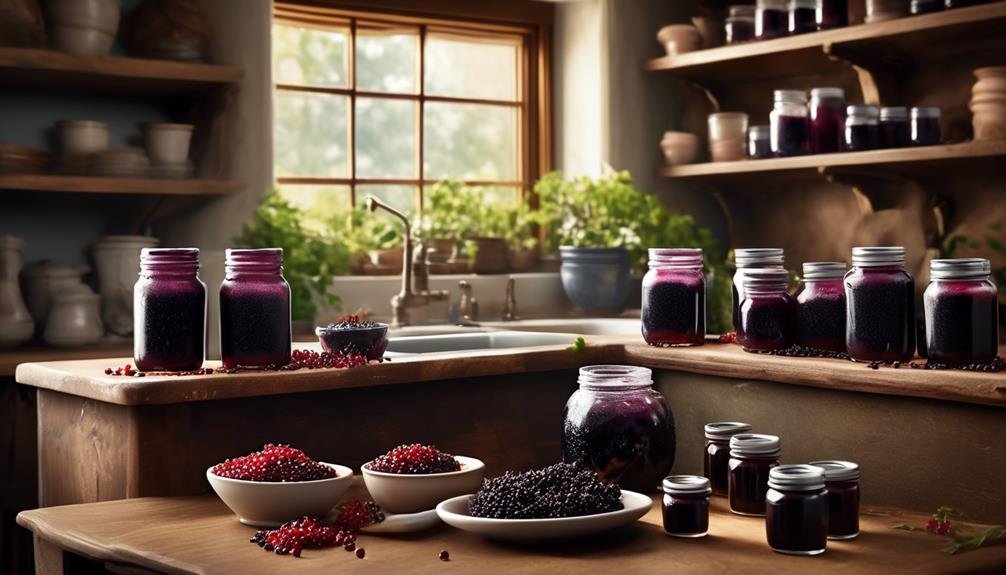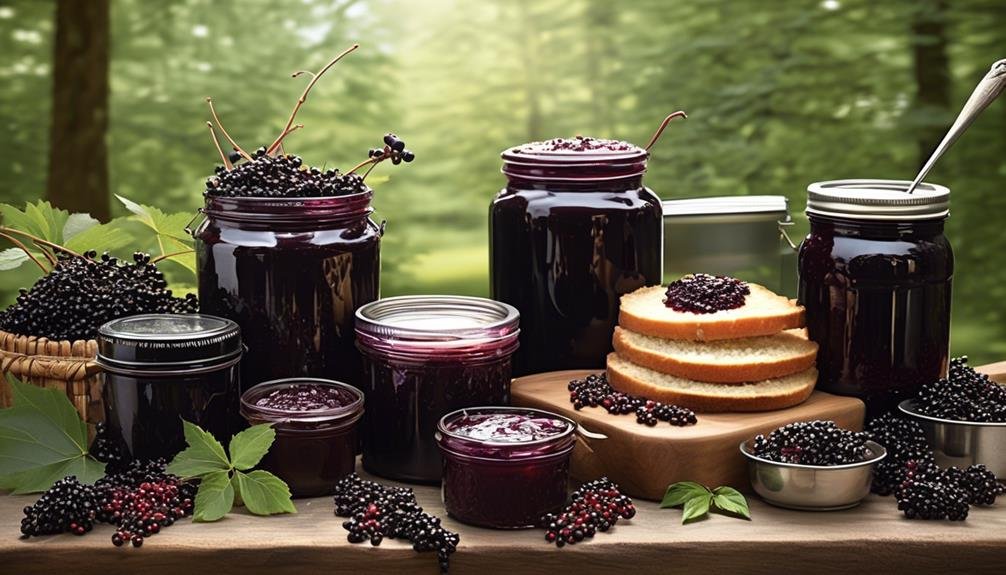Elderberry Jam Recipes

If you enjoy the rich, deep flavor of elderberries, then you'll love exploring different elderberry jam recipes.
Whether you're a seasoned jam maker or just starting out, creating your own batch of elderberry jam can be a rewarding and delicious experience.
From selecting the freshest elderberries to finding the perfect balance of sweetness, there are many tips and techniques to consider when making this classic preserve.
So, if you're ready to elevate your pantry with a homemade treat that captures the essence of elderberries, let's dive into the world of elderberry jam recipes together.
Elderberry Jam Overview
When making elderberry jam, it's essential to understand the characteristics and nuances of this delectable spread.
Elderberries, those dark purple/black berries that grow in clusters on Elderberry Trees, are the star ingredient. These berries, harvested between August and October, are low in pectin, but the addition of lemon juice aids in gel formation and consistency in elderberry jam recipes.
Foraging for elderberries involves picking the ripe berries from hedgerows, woodlands, and gardens, making it a delightful and rewarding activity.
When making elderberry jam, traditional recipes call for granulated cane sugar to sweeten the jam, and alternatives like honey and maple syrup can be used, albeit with potential taste and consistency variations.
Elderberry jam recipes typically don't require additional pectin or straining, making them appreciated for their simplicity and natural ingredients. Understanding these nuances is crucial for a successful elderberry jam-making process.
The next steps involve preparing the berries, cooking them with sugar, lemon juice, and water, and then canning the jam in sterilized jars for future enjoyment.
Essential Ingredients for Elderberry Jam
Picking the ripe elderberries from hedgerows, woodlands, and gardens is just the beginning of creating delicious elderberry jam, as you gather the essential ingredients for this delectable spread. To make jam, you'll need a few key ingredients to bring out the natural flavors and achieve the perfect consistency. Here's a table outlining the essential components for elderberry jam:
| Essential Ingredients | Description | Purpose |
|---|---|---|
| Ripe Elderberries | Dark purple/black elderberry clusters | The main fruit base for the jam |
| Lemon Juice | Freshly squeezed juice | Helps with gel formation due to low pectin content in elderberries |
| Sugar | Granulated cane sugar, honey, or maple syrup | Sweetens the jam and aids in preservation |
| Pectin | Natural pectin or commercial pectin | Assists in setting the jam during the boiling process |
| Water Bath Canning | Large pot with rack for sterilizing jars | Seals the jars for long-term shelf storage |
These essential ingredients work together to create the perfect elderberry jam, balancing sweetness, acidity, and texture. With ripe elderberries at the core, the addition of lemon juice, sugar, pectin, and water bath canning ensures a delightful spread that preserves the essence of the elderberries.
Step-by-Step Elderberry Jam Instructions

To begin making elderberry jam, thoroughly clean and remove any stem material from the ripe elderberries before using them in the recipe. Once the elderberries are stemmed, place them in a large pot and crush them to release their juice.
Add a splash of lemon juice to the pot, which will help the jam achieve the perfect consistency without the need for additional pectin. Then, add the desired amount of sugar to sweeten the jam to your preference. Heat the mixture over medium-high heat, stirring constantly until it reaches a rolling boil.
Allow the jam to boil for 15-20 minutes, or until it thickens to your liking. Keep in mind that the jam will continue to thicken as it cools.
Once the jam has reached the desired consistency, carefully pour it into sterilized jars, leaving a little bit of headspace. Seal the jars tightly and let them cool at room temperature.
If properly sealed, the elderberry jam can be stored on shelves without the need for water bath canning. However, if you prefer, you can also process the jars in a water bath for added preservation.
Enjoy your delicious homemade elderberry jam spread on toast, biscuits, or scones!
Serving Suggestions for Elderberry Jam
Transform your breakfast or snack with the delightful addition of elderberry jam spread on warm scones or freshly baked bread. The rich, fruity flavor of elderberry jam pairs wonderfully with the buttery, flaky texture of scones or the comforting warmth of freshly baked bread.
For a sweet and savory appetizer, try pairing elderberry jam with cheese and crackers. The combination of the tangy cheese and the sweet jam creates a perfect balance of flavors.
If you're looking to add a fruity and tangy flavor to your desserts, consider using elderberry jam as a topping for yogurt or ice cream. You can also incorporate this delicious jam into baked goods such as thumbprint cookies or pastries for a delightful sweet and fruity filling.
Additionally, elderberry jam can be used to create a flavorful glaze for meats when mixed with vinegar and spices, adding a unique twist to your roasted or grilled dishes.
With these serving suggestions, you can explore the versatile ways to enjoy the delightful taste of elderberry jam.
Tips and Tricks for Perfect Elderberry Jam

Wondering how to achieve the perfect consistency for your elderberry jam? When making elderberry jam, the key to achieving the perfect texture lies in the tips and tricks.
Since elderberries are low in pectin, it's essential to use lemon juice to aid in gel formation and ensure the jam sets properly. This simple elderberry jam recipe doesn't require additional pectin. Additionally, when using granulated sugar, the lemon juice helps in the gelling process, resulting in the perfect elderberry jam.
When preparing elderberry jam, it's important to note that properly sealed jam can be stored on shelves without water bath canning. However, if you opt for sugar alternatives like honey or maple syrup, be aware that they may affect the taste and consistency of the jam.
Also, remember to wear old dark clothes and long sleeves when harvesting elderberries to protect yourself from the staining nature of the red berries.
Frequently Asked Questions
Who Should Not Take Elderberry?
Avoid elderberry if you have autoimmune diseases, chronic illness, or take immunosuppressant medications due to health risks and potential side effects. Pregnant or breastfeeding women, children under 1 year, and those with allergies should also be cautious.
Is Elderberry Jam Good for You?
Yes, elderberry jam is good for you. It provides numerous health benefits due to its high nutritional content, including immune support and antioxidant properties. Incorporating it into homemade recipes adds both medicinal and culinary value to your diet.
Why Won T My Elderberry Jam Set?
If your elderberry jam won't set, try adding citrus for natural pectin, adjust sugar ratios, and use proper cooking techniques. Test for doneness and consider alternative thickeners. Sterilize jars for longer shelf life and troubleshoot with gel tests.
Can You Eat Raw Elderberries?
Can you eat raw elderberries? No, raw elderberries can cause an upset stomach. Cooking elderberries makes them safe to eat. They have health benefits and are used in culinary recipes like elderberry syrup, tea, wine, and pie.

Related Posts